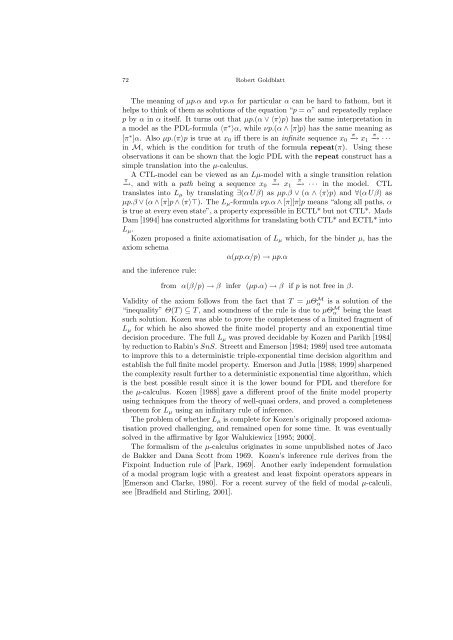MATHEMATICAL MODAL LOGIC: A VIEW OF ITS EVOLUTION
MATHEMATICAL MODAL LOGIC: A VIEW OF ITS EVOLUTION
MATHEMATICAL MODAL LOGIC: A VIEW OF ITS EVOLUTION
Create successful ePaper yourself
Turn your PDF publications into a flip-book with our unique Google optimized e-Paper software.
72 Robert GoldblattThe meaning of µp.α and νp.α for particular α can be hard to fathom, but ithelps to think of them as solutions of the equation “p = α” and repeatedly replacep by α in α itself. It turns out that µp.(α ∨ 〈π〉p) has the same interpretation ina model as the PDL-formula 〈π ∗ 〉α, while νp.(α ∧ [π]p) has the same meaning as[π ∗ π π]α. Also µp.〈π〉p is true at x 0 iff there is an infinite sequence x 0 −→ x1 −→ · · ·in M, which is the condition for truth of the formula repeat(π). Using theseobservations it can be shown that the logic PDL with the repeat construct has asimple translation into the µ-calculus.A CTL-model can be viewed as an Lµ-model with a single transition relationππ π−→, and with a path being a sequence x 0 −→ x1 −→ · · · in the model. CTLtranslates into L µ by translating ∃(α Uβ) as µp.β ∨ (α ∧ 〈π〉p) and ∀(α Uβ) asµp.β ∨ (α ∧ [π]p ∧ 〈π〉⊤). The L µ -formula νp.α ∧ [π][π]p means “along all paths, αis true at every even state”, a property expressible in ECTL* but not CTL*. MadsDam [1994] has constructed algorithms for translating both CTL* and ECTL* intoL µ .Kozen proposed a finite axiomatisation of L µ which, for the binder µ, has theaxiom schemaα(µp.α/p) → µp.αand the inference rule:from α(β/p) → β infer (µp.α) → β if p is not free in β.Validity of the axiom follows from the fact that T = µΘαM is a solution of the“inequality” Θ(T ) ⊆ T , and soundness of the rule is due to µΘαM being the leastsuch solution. Kozen was able to prove the completeness of a limited fragment ofL µ for which he also showed the finite model property and an exponential timedecision procedure. The full L µ was proved decidable by Kozen and Parikh [1984]by reduction to Rabin’s SnS. Streett and Emerson [1984; 1989] used tree automatato improve this to a deterministic triple-exponential time decision algorithm andestablish the full finite model property. Emerson and Jutla [1988; 1999] sharpenedthe complexity result further to a deterministic exponential time algorithm, whichis the best possible result since it is the lower bound for PDL and therefore forthe µ-calculus. Kozen [1988] gave a different proof of the finite model propertyusing techniques from the theory of well-quasi orders, and proved a completenesstheorem for L µ using an infinitary rule of inference.The problem of whether L µ is complete for Kozen’s originally proposed axiomatisationproved challenging, and remained open for some time. It was eventuallysolved in the affirmative by Igor Walukiewicz [1995; 2000].The formalism of the µ-calculus originates in some unpublished notes of Jacode Bakker and Dana Scott from 1969. Kozen’s inference rule derives from theFixpoint Induction rule of [Park, 1969]. Another early independent formulationof a modal program logic with a greatest and least fixpoint operators appears in[Emerson and Clarke, 1980]. For a recent survey of the field of modal µ-calculi,see [Bradfield and Stirling, 2001].
















